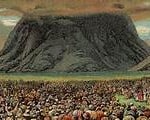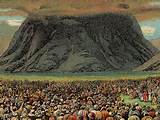Though not clearly described in the Torah as the day of the receiving of the Torah Shavuot is clearly that. We read the following in the book of Sh’mot/Exodus 19:1: “In the third month after the children of Israel were gone forth out of the land of Egypt, that same day (bayom hazeh) came they into the wilderness of Sinai.”
They arrive on “that same day,” the first day of the month of Sivan, the third month. Moshe’s ascent of the mountain followed by the period of preparation amounted to five days, and the revelation, as a result, occurred on the sixth day. This day corresponds exactly to the fiftieth day after Passover, physical liberation followed by spiritual liberation. The reason that the specific event is not described by date in the Bible is, according to the sages, to teach the message the Torah continues to be “received” every day of our lives and not on any specific date.
Yet, after the awesome revelation of the Ten Statements, Moshe went up for forty days and descended on the 17th day of Tamuz with the Torah. He broke the tablets upon seeing the fall of the Jewish people. After forty days, he went up again for another forty-day period, finally descending on Yom Kippur, the day of Atonement.
This fact implies that the festival of Shavout represents not the giving of the Torah, but rather the Jewish people’s resolve to stand at the foot of the mountain to receive the Torah. That decision to stand and enter into a covenant of obedience to G-d’s direction marks the power of that day. Shavuot represents the wedding of the Jewish people to their Creator. G-d is seen as the groom beckoning His bride, the people of Israel, to stand under His cloud-huppah covering and to accept His marriage contract (ketubah), His Torah. The joy of this festival is that this people agreed to enter the huppah.
